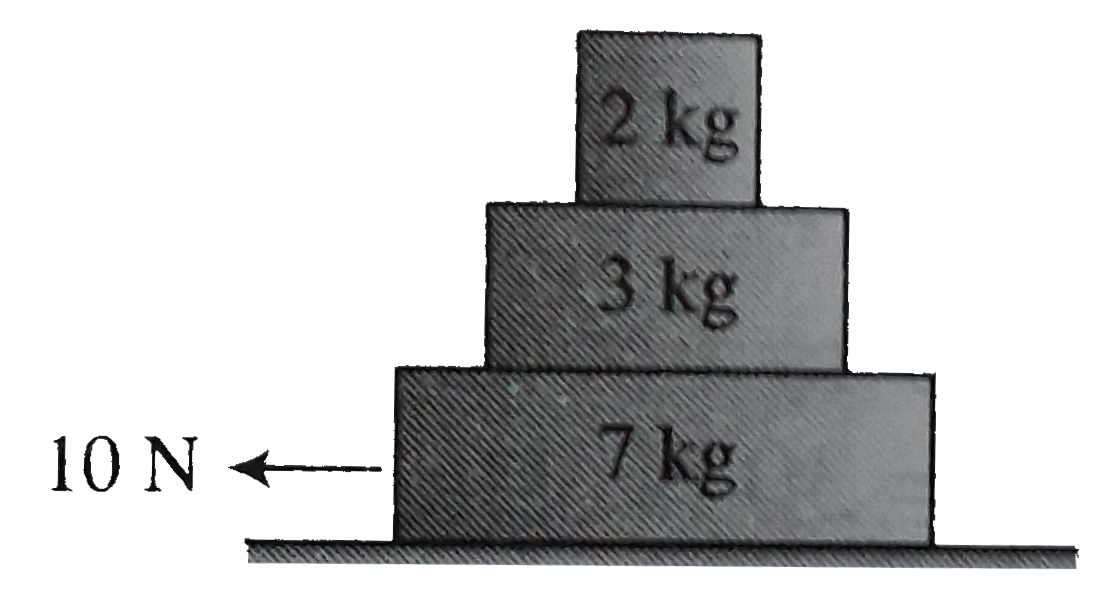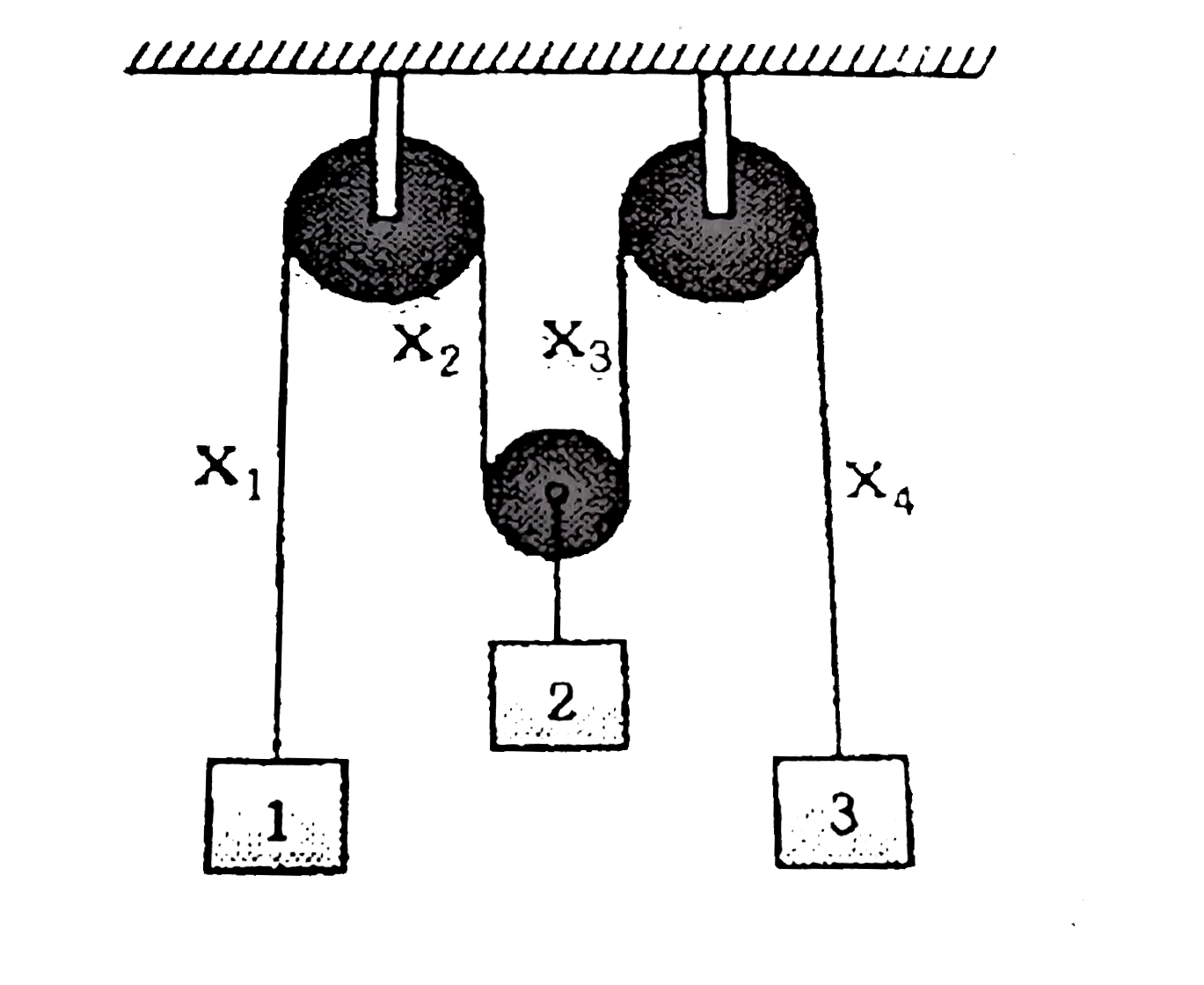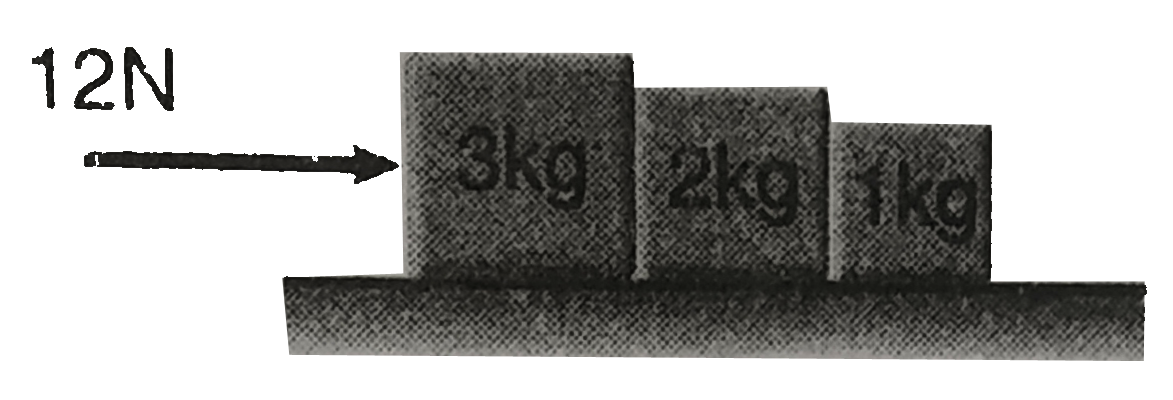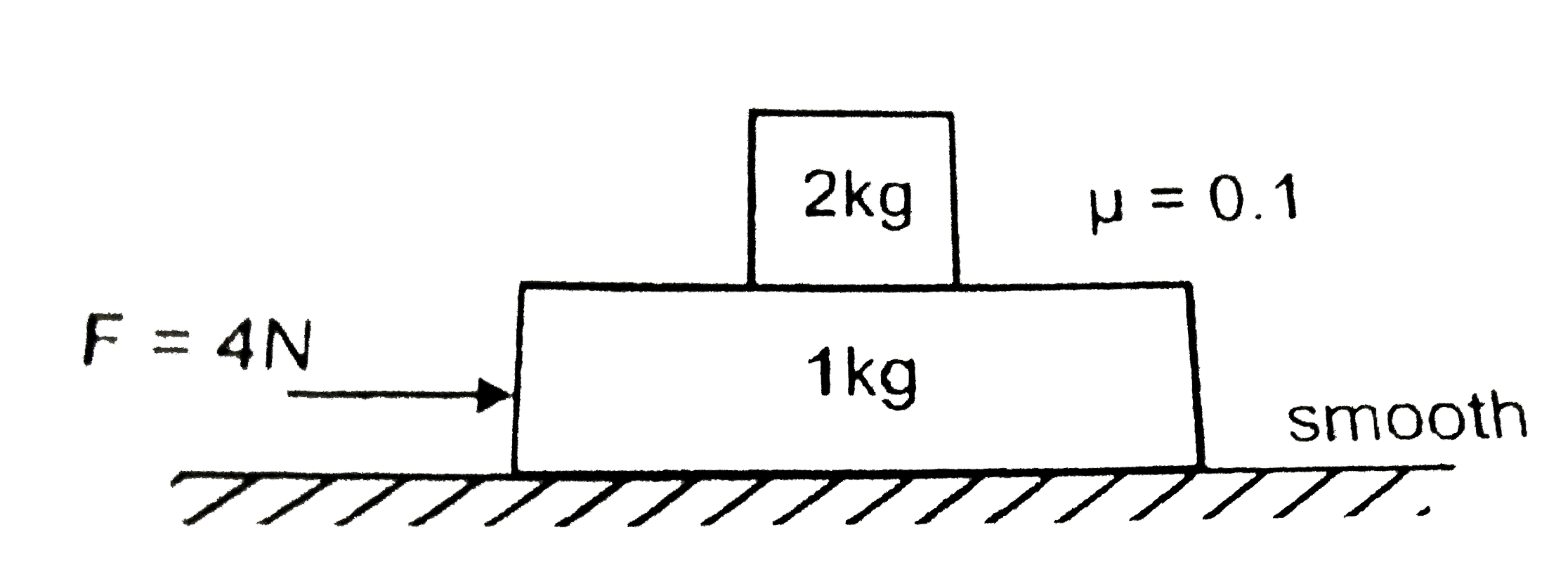Find the acceleration a1,a2anda3 of the three blocks shown in Fig if a horizontal force of 10N is applied on

(a) 2kg blocks, (b) 3kg blocks and ( c) 7kg blocks (Take g=10ms−2)
When force of 10N is applied on 2kg blocks . The limiting friction force between 2kgand3kg blocks
fl1=0.2×2kg=0.2×2×10=4N
The limiting friction force between3kg and 7kg
fl2=0.3×5g
=0.3×5×10=15N
After proper analysis , we find that 2kg will slip over 3kg but 3kg will not slip over 7kg
Thus the we have a1=10−42=3ms−2
a2=a3=43+7=0.4ms−2
Since a1 is coming out to be greater than a2,2kg will slip over 3kg

b. When force of 10N is applied on 3kg blocks
Let us assume that all these blocks move together with common acceleration a then

a=102×3+7=56ms−2
Under this assumption
Friction between 2kg and 3kg
f1=2a=2×56=53N<fl1
Friction between 3kg and 7kg
f2=7a=(7×5)(6)353N<fl2
Hence, no slipping occut any where
c. When force of 10N is applied on 7kg block. The acceleration of the whole system

a=102×3+7=56ms−2
The pseudo force on 2kg block =2×56=53N ,which is less than the friction forces between 2kg and 3kg blocks so they move together.
Now check whether 2kg and 3kg move together over 7kg blocks The pseudo force on (2+3)kg is 5×56=256N , which is also less than friction force between 3kg and 7kg blocks move with a common acceleration of 5/6ms−2 Therefore
a=a1=a2=a3102+3+7=56ms−2
Topper's Solved these Questions
- NEWTON'S LAWS OF MOTION 2BOOK - CENGAGE PHYSICS ENGLISHCHAPTER - NEWTON'S LAWS OF MOTION 2EXERCISE - Exercise 7.1
25 Videos
- NEWTON'S LAWS OF MOTION 2BOOK - CENGAGE PHYSICS ENGLISHCHAPTER - NEWTON'S LAWS OF MOTION 2EXERCISE - Exercise 7.2
16 Videos
- NEWTON'S LAWS OF MOTION 2BOOK - CENGAGE PHYSICS ENGLISHCHAPTER - NEWTON'S LAWS OF MOTION 2EXERCISE - Integer type
1 Video
- NEWTON'S LAWS OF MOTION 1BOOK - CENGAGE PHYSICS ENGLISHCHAPTER - NEWTON'S LAWS OF MOTION 1EXERCISE - Integer
5 Videos
- PROPERTIES OF SOLIDS AND FLUIDSBOOK - CENGAGE PHYSICS ENGLISHCHAPTER - PROPERTIES OF SOLIDS AND FLUIDSEXERCISE - INTEGER_TYPE
2 Videos
Similar Questions
Find the relation between acceleration of blocks a1,a2 and a3.

View SolutionThree blocks of masses 5 kg, 3 kg and 2 kg are placed on a rough surface as shown in figure. Coefficient of friction between block and surface is same for all the blocks and is equal to μ=0.2 . A horizontal force of 15 N is applied on 5 kg block. The force exerted by 3 kg block on 2 kg block is : (g = 10 m/s2)

View Solution
Knowledge Check
Two blocks A and B of masses 10 kg and 15 kg are placed in contact with each other rest on a rough horizontal surface as shown in the figure. The coefficient of friction between the blocks and surface is 0.2. A horizontal force of 200 N is applied to block A. The acceleration of the system is (Take g=10ms−2)
 A4ms−2B6ms−2C8ms−2D10ms−2
A4ms−2B6ms−2C8ms−2D10ms−2
A 3 kg block is placed over a 10 kg block and both are palced on a smooth horizontal surface. The coefficient of friction between the block is 0.2 . If a horizontal force of 20 N is applied to 3 kg block, accelerations of the two block in ms−2 are (take, g=ms−2)

View SolutionThree blocks of masses 3kg,2kg and 1kg are placed side by side on a smooth surface as shown in figure. A horizontal force of 12N is applied on 3kg block. Find the net force on 2kg block.

View SolutionThree blocks of masses 3kg,2kg and 1kg are placed side by side on a smooth surface as shown in figure. A horizontal force of 12N is applied on 3kg block. Find the net force on 2kg block.

View SolutionA 5 kg block is placed on the top of a 15 kg block as shown in figure . A horizontal force of 60 N is applied to the 15 kg block and the 5kg block is tied to the wall . The coefficient of friction between moving surfaces is 0.2

(a) Draw the free body diagram for each block w.r.t ground and identify the action reaction forces between two blocks .
(b) Determine the tension in the string and magnitude of the acceleration of the 15 kg block .
View Solution2gk block is kept on 1kg block as shown . The friction between 1kg block and fixed surface is absent and the coefficient of friction between 2kg block is μ=0.1. A constant horizontal force F=4N is applied on 1kg block. If the work done by the friction on 1kg block in 2s is −XJ, then find X. Take g=10m/s2.

View SolutionThe acceleration of the 10 kg mass block shown in the figure is : -

View SolutionFind the acceleration of the two blocks . The system is initialy at rest and the friction are as shown in fig .Given mA=mB=10kg

View Solution
